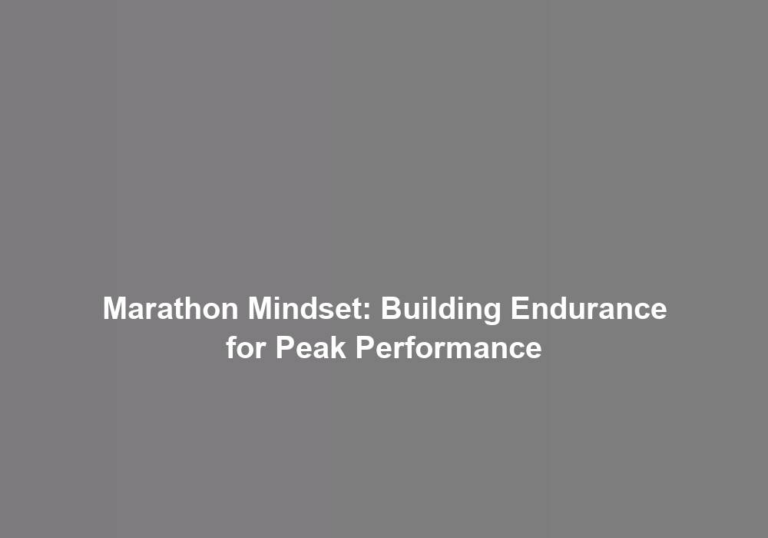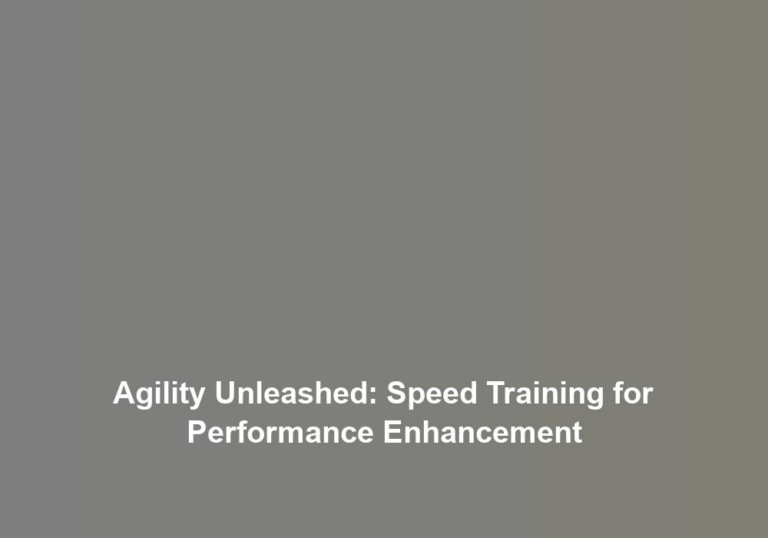Quick Steps: Maximizing Speed and Agility for Athletic Success
When it comes to excelling in athletics, mastering the art of quick steps can be the key to reaching the pinnacle of performance. The ability to swiftly navigate the field or court with precision and agility is a coveted skill that can elevate your game to new heights. But how exactly can you enhance your speed and agility to achieve athletic success? There are proven techniques and strategies that can sharpen your movements and take your performance to the next level. Whether youG??re a seasoned athlete or just starting out, understanding the nuances of maximizing speed and agility can be the game-changer youG??ve been looking for.
Importance of Speed and Agility
To excel in sports, athletes must prioritize the development of speed and agility as integral components of their training regimen. Speed and agility are essential for athletic success, often more so than strength alone. While strength is undoubtedly important, the ability to swiftly change direction, accelerate, and decelerate is what sets top athletes apart. This is not to say that strength is irrelevant, but rather that speed and agility play a critical role in determining the outcome of many sporting events.
In sports, the difference between winning and losing can often come down to split-second movements. The ability to outrun an opponent, react quickly to an incoming ball, or swiftly change direction to evade a defender can be the defining factor in achieving victory. Athletes need to understand that while strength can provide a solid foundation, it is speed and agility that often determine who emerges victorious.
Agility in sports is particularly crucial as it encompasses a range of movements including acceleration, deceleration, cutting, and lateral shuffling. These movements are essential in sports such as soccer, basketball, and tennis, where the ability to swiftly change direction can make all the difference. Sports science has demonstrated that agility training not only enhances on-field performance but also reduces the risk of injury, making it a fundamental aspect of an athleteG??s training program.
Effective Training Techniques
To enhance your speed and agility, incorporating specific speed drills and agility exercises into your training regimen is crucial. Speed drills such as sprints, shuttle runs, and ladder drills can help improve acceleration and top speed. Additionally, agility exercises like cone drills, ladder drills, and plyometric exercises can enhance your ability to change direction quickly and efficiently.
Speed Drills
One effective way to improve speed and agility is through incorporating a variety of speed drills into your training regimen. By focusing on acceleration techniques, sprint mechanics, speed endurance, and reaction time, you can enhance your athletic performance significantly. Below are some effective speed drills that target different aspects of speed and agility:
| Speed Drill | Focus |
|---|---|
| Sled Sprints | Acceleration techniques |
| Ladder Drills | Sprint mechanics |
| Interval Training | Speed endurance |
| Reactive Shuttle Runs | Reaction time |
| Hill Sprints | Acceleration techniques |
Incorporating these speed drills into your training routine will help you develop the necessary skills to excel in your sport. Remember to focus on proper form and technique to maximize the benefits of each drill.
Agility Exercises
Incorporate agility exercises that focus on quick directional changes and dynamic movements to enhance your athletic performance and overall agility. Try the following exercises to improve your agility:
- Agility ladder: Use an agility ladder to perform ladder drills, such as the icky shuffle or lateral runs, to enhance foot speed and coordination.
- Cone drills: Set up cones in various patterns and practice weaving in and out of them to simulate rapid changes in direction during sports.
- Box drills: Create a square using cones and perform drills that involve moving quickly in different directions within the box to improve multidirectional speed.
- Reaction drills: Use visual or auditory cues to practice reacting quickly and changing direction, mimicking real-game scenarios for enhanced agility.
These exercises target specific movements and skills that directly translate to improved agility on the field or court.
Dynamic Warm-Up Routines
Performing dynamic warm-up routines before engaging in athletic activities helps to prepare your body for the demands of exercise by increasing blood flow, loosening muscles, and improving joint mobility. Injury prevention is a key focus of dynamic warm-ups, as they help reduce the risk of strains, sprains, and other common sports-related injuries. Incorporating muscle activation techniques into your warm-up routine can help prime your muscles for optimal performance during your athletic activity. This can be achieved through exercises such as resistance band walks, bodyweight squats, and lateral lunges, which activate and engage the major muscle groups used in your specific sport.
Sport-specific warm-ups are essential for preparing the body for the specific movements and energy systems required in your chosen activity. For example, a soccer player may include drills that mimic sprinting, cutting, and kicking motions, while a basketball player may focus on agility ladder drills and shooting practice. These warm-ups not only increase performance but also enhance the mind-body connection, allowing for better coordination and movement efficiency.
Flexibility drills are also a crucial component of dynamic warm-up routines, as they help improve range of motion and reduce muscle stiffness. Dynamic stretching exercises like leg swings, arm circles, and hip rotations can help enhance flexibility, leading to improved athletic performance and reduced risk of injury. By incorporating these elements into your dynamic warm-up routine, you can maximize your speed and agility while minimizing the risk of injury, ultimately contributing to your overall athletic success.
Essential Footwork Drills
To build on the foundation set by dynamic warm-up routines, integrating essential footwork drills into your training regimen is vital for enhancing agility, speed, and overall athletic performance. Here are four essential footwork drills that will help you take your athletic abilities to the next level:
-
Ladder Drills: Utilize an agility ladder to perform drills that focus on quick and precise foot movements. Incorporate exercises such as the two-in, two-out drill to improve coordination and balance.
-
Cone Exercises: Set up a series of cones in various patterns to work on your ability to change direction rapidly. Use techniques like the T-drill to simulate game-like scenarios that require quick changes in movement.
-
Athletic Footwork: Practice athletic stances and movements such as the defensive shuffle for sports like basketball, or the drop step for baseball. These drills enhance your ability to react quickly and explosively in any direction.
-
Agility Ladder Drills: Incorporate agility ladder drills to improve your footwork, speed, and coordination. Perform exercises like the lateral shuffle or the icky shuffle to enhance your ability to move laterally with precision and speed.
Speed-Enhancing Equipment
To maximize your speed and agility, incorporating speed-enhancing equipment into your training regimen is essential. Sprinting shoes designed for optimal traction and support can help you achieve faster foot turnover and stride length. Additionally, resistance bands are effective tools for building strength and power, ultimately improving your speed and explosiveness on the field or track.
Sprinting Shoes
Maximize your speed and agility on the track with the right pair of sprinting shoes designed to enhance your performance. When choosing sprinting shoes, consider the following:
- Fit: A snug and secure fit is essential for minimizing slippage and maximizing power transfer during each stride.
- Technology: Look for shoes with advanced athletic footwear technology, such as lightweight materials and responsive cushioning, to improve speed and reduce fatigue.
- Spikes: Opt for shoes with replaceable spikes, allowing you to customize traction based on track conditions and personal preference.
- Flexibility and Support: Seek a balance between flexibility and support to optimize your footG??s natural movement while maintaining stability for powerful sprints.
Selecting the right sprinting shoes can significantly impact your performance, so choose wisely to gain a competitive edge.
Resistance Bands
When seeking to enhance your speed and agility on the track, consider incorporating resistance bands into your training regimen as a complement to your sprinting shoes. Resistance bands offer various variations, such as looped bands, tube bands, and therapy bands, that can be utilized for targeted muscle activation and injury prevention. Integrate resistance band exercises into a circuit to improve muscle strength, power, and endurance specific to sprinting. This can be achieved by performing exercises like lateral band walks, resisted sprints, and band hip flexion. By incorporating resistance bands into your training routine, you can effectively enhance your sprinting performance while minimizing the risk of injuries. Remember to consult with a fitness professional to ensure proper form and technique when using resistance bands to maximize their benefits.
Integrating Speed Into Game Situations
Integrating speed into game situations requires athletes to strategically apply their acceleration and agility to outmaneuver opponents and create scoring opportunities. To effectively integrate speed into game scenarios, consider the following:
-
Game Simulations: Utilize game simulations during training to mimic real game scenarios and improve decision-making under pressure. Incorporating speed drills within these simulations can help athletes adapt to the fast-paced nature of competitive play.
-
On-Field Application: Practice on-field application of speed and agility by focusing on quick transitions, rapid change of direction, and explosive bursts of speed. Incorporating these elements into game-specific drills can enhance an athleteG??s ability to execute high-speed maneuvers during competitive matches.
-
Strategic Positioning: Develop an understanding of strategic positioning to anticipate game situations and exploit opportunities for speed-driven advantages. By strategically positioning yourself on the field, you can maximize the effectiveness of your speed and agility in creating game-changing plays.
-
Game Analysis: Analyze game footage to identify instances where speed and agility could have been leveraged more effectively. By studying past games, athletes can gain insights into how speed can be integrated into specific game situations, allowing for continuous improvement and refinement of in-game speed application.
Conclusion
So, are you ready to take your athletic performance to the next level? By incorporating effective training techniques, dynamic warm-up routines, essential footwork drills, and speed-enhancing equipment into your regimen, you can maximize your speed and agility. DonG??t forget to integrate these skills into game situations to truly see improvement. With commitment and dedication, you can reach your full potential on the field or court. Are you ready to leave your competition in the dust? Keep pushing yourself and watch your speed and agility soar.







